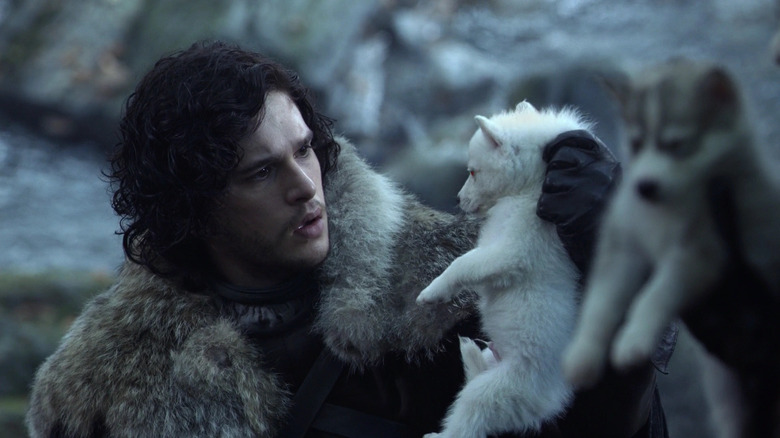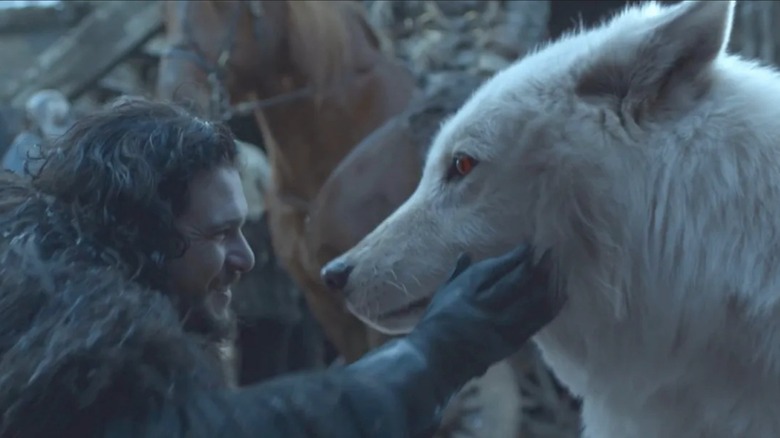Game Of Thrones' Adorable Dire Wolves Have Been Brought Back From Extinction
The North really does remember. The genetic engineering company Colossal Biosciences announced on the morning of April 7 that they've successfully brought direwolves back to life. Well, sort of. They took dire wolf DNA found from old fossils and, as The Hollywood Reporter reported, mixed them with "the genetic code of a gray wolf, the species' closest living relative." They now have three young, living dire wolves roaming around, just three shy of what the Stark family found at the start of "Game of Thrones." As THR explained:
"The Colossal company has named its two new male dire wolves — a pair of six-month old adolescents — Romulus and Remus, after the mythological twin founders of Rome, who were said to have been raised by a wolf. And in an homage to 'Game of Thrones' [character] Daenerys Targaryen, it's christened a female puppy Khaleesi. The trio are now living in an enclosed preserve of more than 2,000 acres at an undisclosed location. They are expected to mature at 130 to 150 pounds — by contrast, a typical gray wolf clocks in at about 80 to 100 pounds."
Colossal Biosciences has revealed the news on X, including pictures of the new wolves and revealing their birthdays as being October 1, 2024. They also revealed that they gave the wolves white fur, much like Jon Snow's dire wolf Ghost in "Game of Thrones." The choice was based on scientific evidence that this was the real color of dire wolves' fur 10,000 years ago, although the fact that it tied in nicely to the hit fantasy series didn't hurt either.
The future is so bright, you might need to take your shades OFF for this one. De-extinction is now a reality. Meet Khaleesi—a dire wolf pup, reborn on January 31, 2025, more than 10,000 years after her species vanished.
It's not #JurassicPark but this moment signals the start of... pic.twitter.com/cOy63LCR53
— Colossal Biosciences® (@colossal) April 7, 2025
The technology seems similar to that in 'Jurassic Park,' although thankfully dire wolves aren't as dangerous
"Many people view dire wolves as mythical creatures that only exist in a fantasy world, but in reality, they have a rich history of contributing to the American ecosystem," George R. R. Martin wrote in a statement alongside Colossal's announcement. Martin has reportedly signed on as an investor to the project and has even gotten to meet Romulus and Remus at their preserve. The fact that dire wolves were a real animal, like the dinosaurs long before them, raises an obvious question: Can dinosaurs be brought back too? Can the "Jurassic Park" franchise be made into reality?
"Not possible," the Colossal Biosciences X account replied when asked. "But hey ... dire wolves are here."
For some "Game of Thrones" fans, the news is bittersweet, and not just because Khaleesi is a bad name for a dire wolf. As one viral tweet reacting to the news put it, "Bro, we literally got actual dire wolves before we got 'Winds of Winter.'" He's referring to the sixth book in the "A Song of Ice and Fire" series, which fans have been waiting on since 2011. Most fans have given up hope of the book series ever finishing at this point, especially since there's still a seventh book that needs completing too.
Still, fans of the Starks (and fans of science in general) should be thrilled about this news. It offers some extra hope for all the endangered species out there, and it raises the possibility of bringing back other beloved extinct animals like the Woolly Mammoth. ("Ice Age" fans would certainly be thrilled about that reveal.) In TIME Magazine's report on these new dire wolves, they covered Colossal's ambitions going forward:
"The dire wolf isn't the only animal that Colossal, which was founded in 2021 and currently employs 130 scientists, wants to bring back. Also on their de-extinction wish list is the woolly mammoth, the dodo, and the thylacine, or Tasmanian tiger. Already, in March, the company surprised the science community with the news that it had copied mammoth DNA to create a woolly mouse, a chimeric critter with the long, golden coat and the accelerated fat metabolism of the mammoth."

